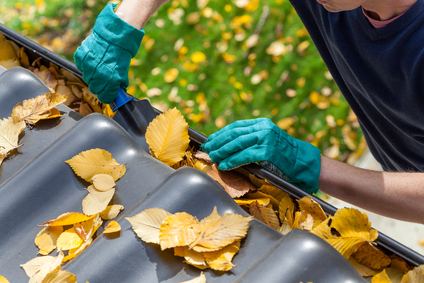Gutter Cleaning – Spring Home Maintenance
The southern west coast of British Columbia is well known for it’s significant rainfall amounts each year. Typically, rainfall amounts are at their highest from October to March/April. This means that September and April are the ideal months to clean your gutters.Gutters are an important part of your home. They catch all the rain runoff from your roof, and divert the water into the perimeter drain. This protects the roofline trim, siding, windows, doors, and foundation of your home from water damage, as well as preventing flooding in basement and crawlspaces.
It is important to clean debris from your gutters before the rainy season and once it’s over to ensure they do not overflow or get damaged. If there are a lot of trees near your house, you may want to do it more frequently. This not only makes it easier to do each time, but prevents any possible damage to your house. Cleaning at the beginning of the season ensures that they are clear to catch not only the rainwater, but also any debris that falls during windstorms over the winter. Cleaning at the end of the season ensures there is no standing water for the summer, which is attractive to mosquitoes and carpenter ants.
Because gutters are located along the roofline of your home, it is important that you do this safely. If your home is more than one storey high, or you are uncomfortable on a ladder, it is advised to hire a professional to glean your cutters as they have the right equipment to perform the job safely. If you’re ready to tackle the job yourself, you just need some simple tools to get it done:
- Heavy gloves
- Safety glasses
- Sturdy ladder
- Bucket or garbage bags
- Garden trowel
- Garden hose with high pressure nozzle
- Tarp or drop cloth
- Plumber’s snake/auger, if needed
Before you begin, sweep or rake any debris off of your roof so that it doesn’t fill up your gutters the next time it rains. Gather all of your equipment so it’s ready for you. Lay out a tarp or drop cloths to protect the area you’re working in from falling debris. Stand the ladder up to where you want to begin; if you have to lean your ladder on the gutters, place a 2×4 board inside the gutter to protect it from dents. Always be safe using a ladder, ensuring it is sturdy at all times (get someone to hold it for you!) and never stand on the top two rungs.
Start at a drain spout or low spot and scoop out as much debris as you can with a trowel and collect it in a bucket or garbage bag. Move away from the drain spout, up toward the higher section of the gutter. Then, use your hose with a high pressure nozzle attached to flush the gutter, moving toward the drain spout. Scrub where needed to remove encrusted debris. Finally, flush the downspouts with your hose to ensure they’re flowing freely. If they aren’t clear, use a plumber’s snake or auger to free the clog and remove it from the bottom of the downspout.
As with many jobs, the more frequently you do it, the easier it will be to do. There are lots of neat tools that can help you take care of the task too, what’s your favourite?




